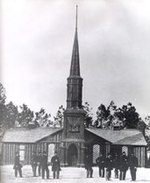Petersburg is an independent city in the Commonwealth of Virginia in the United States. As of the 2020 census, the population was 33,458 with a majority African American. The Bureau of Economic Analysis combines Petersburg (along with the city of Colonial Heights) with Dinwiddie County for statistical purposes. The city is 21 miles (34 km) south of the commonwealth (state) capital city of Richmond.
It is located at the fall line (the head of navigation of rivers on the U.S. East Coast) of the Appomattox River (a tributary of the longer larger James River which flows east to meet the southern mouth of the Chesapeake Bay at the Hampton Roads harbor and the Atlantic Ocean). In 1645, the Virginia House of Burgesses ordered Fort Henry built, which attracted both traders and settlers to the area. The Town of Petersburg, chartered by the Virginia legislature in 1784, incorporated three early settlements, and in 1850 the legislature elevated it to city status.Petersburg grew as a transportation hub and also developed industry. It was the final destination on the Upper Appomattox Canal Navigation System, which opened in 1816, to a city mostly rebuilt after a devastating 1815 fire. When its Appomattox River port silted up, investors built an 8-mile railroad to City Point on the James River, which opened in 1838 (and was acquired by the city and renamed the Appomattox Railroad in 1847). As discussed below, that became one of four railroads built (some with government subsidies) constructed (with separated terminals to the advantage of local freight haulers) before the American Civil War. In 1860, the city's industries and transportation combined to make it the state's second largest city (after Richmond). It connected commerce as far inland as Farmville, Virginia at the foothills of the Blue Ridge and the Appalachian Mountains chain, to shipping further east into the Chesapeake Bay and North Atlantic Ocean.
During the American Civil War (1861–1865), because of this railroad network, Petersburg became critical to Union plans to capture the Confederate States national capital established early in the war at Richmond. The 1864–65 Siege of Petersburg, which included the Battle of the Crater and nine months of trench warfare devastated the city. Battlefield sites are partly preserved as Petersburg National Battlefield by the National Park Service of the U.S. Department of the Interior. Petersburg rebuilt its railroads, including a connecting terminal by 1866, although it never quite regained its economic position because much shipping traffic would continue to the Norfolk seaport. After the consolidations of smaller railroads, both the CSX and Norfolk Southern railway networks serve Petersburg.
Petersburg has the oldest free black settlements in the state at Pocahontas Island. Two Baptist churches in the city, whose congregations were founded in the late 18th century, are among the oldest black congregations and churches in the United States. In the post-bellum period, a historically black college which later developed as the Virginia State University was established nearby in Ettrick in Chesterfield County. In the 20th century, these and other black churches were leaders in the national Civil Rights Movement of the 1950s-1960s. Richard Bland College, now a junior college, was originally established here as a branch of Williamsburg's famed College of William and Mary.
Petersburg remains a transportation hub. Area highways include Interstate Highways 85, 95, and U.S. Route highways with 1, 301, and 460. Both CSX and Norfolk Southern rail systems maintain transportation centers at Petersburg. Amtrak serves the city with daily Northeast Regional passenger trains to Norfolk, Virginia, and long-distance routes from states to the South.In the early 21st century, Petersburg civic leaders promote the city's historical attractions for heritage tourism, as well as industrial sites reachable by the transportation infrastructure. The federal government is also a major employer, with nearby Fort Gregg-Adams, as home of the United States Army's Sustainment Center of Excellence, and the Army's Logistics Branch, Ordnance, Quartermaster, and Transportation Corps.






